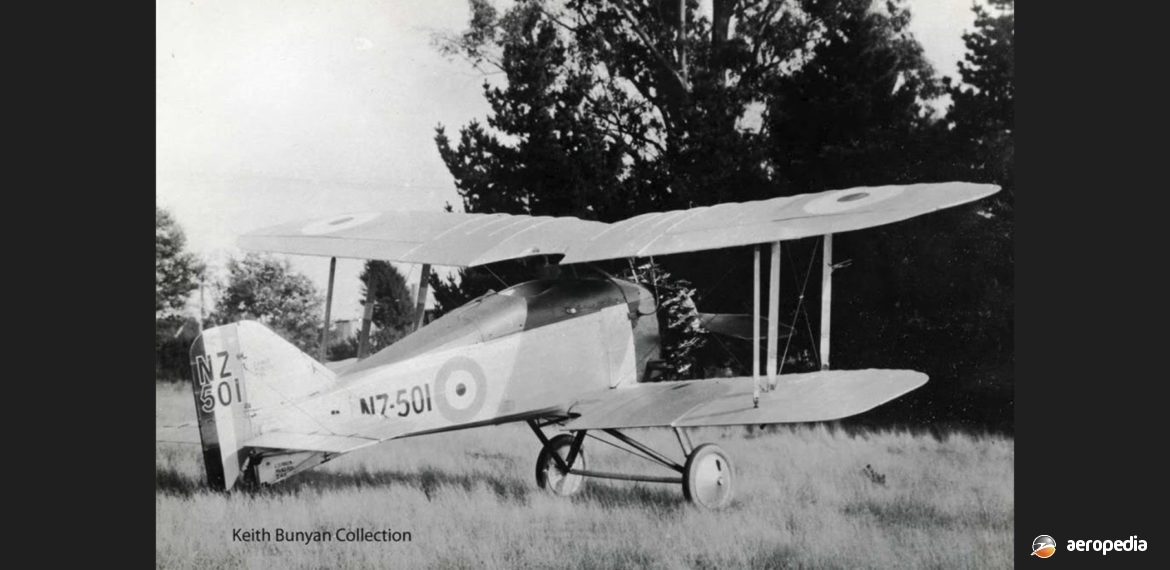Photograph:
Gloster Grebe NZ501 in New Zealand in the 1930s (Keith Bunyan collection – RNZAF)
Country of origin:
United Kingdom
Description:
Single-seat biplane fighter
Power Plant:
One 287 kw (385 hp) Armstrong Siddeley Jaguar IV 14-cylinder, direct drive, air-cooled radial engine
Specifications:
- Wingspan: 8.96 m (29 ft 4 in)
- Length: 6.18 m (20 ft 3 in)
- Height: 2.83 m (9 ft 3 in)
- Wing area: 23.59 m² (254 sq ft)
- Max speed at sea level: 261 km/h (162 mph)
- Stalling speed: 85 km/h (53 mph)
- Service ceiling: 7,163 m (23,500 ft)
- Time to 6,096 m (20,000 ft): 24 mins
- Climb to 7,010 m (23,000 ft): 23 mins
- Endurance at 6,096 m (20,000 ft), including climb to altitude: 3 hours
- Empty weight: 780 kg (1,720 lb)
- Loaded weight: 1,179 kg (2,600 lb)
Armament:
Two fixed 7.7 mm (0.303 in) Vickers synchronised machine guns using Constantinesco interrupter gear; four 9 kg (20 lb) Cooper bombs
History:
The Gloster Grebe was designed by Henry Philip (Harry) Folland for the Gloster Aircraft Company, this Company originating in 1917 as the Gloucestershire Aircraft Company which, at a plant near Cheltenham, established itself by building wooden aeroplanes for the Royal Flying Corps (RFC), and later the Royal Air Force (RAF).
With the arrival of the Armstrong Siddeley Jaguar III engine the aviation industry in the United Kingdom set about designing and building fighters with this power plant. One of these was the Grebe, the prototype of which (J6969) was flown in 1923 with a 242 kw (325 hp) Armstrong Siddeley Jupiter III engine. It was a wood structured sesquiplane with fabric covering and impressed pilots, being faster than its predecessor, the Sopwith Snipe.
The Grebe immediately went into production for the RAF and entered service, with the Jaguar IV engine providing 298 kw (400 hp), as the Grebe II, the first of this model (serial 7283) flying in August 1923, entering service with the newly re-formed No 111 Squadron. Other RAF units which operated the Grebe were Nos 19, 25, 29, 32 and 56 from Duxford, Hawkinge, Kenley and Biggin Hill. Production concluded after 110 Grebe MK II fighters, and 20 two-seat Grebe Mk IIDC trainers had been delivered.
A few Grebes were attached to Martlesham Heath and two (J7385 and J7400) were attached to the airship R-33 for air-launching trials in 1926. The type was retired in 1929. One example received a civil registration (G-EBHA), this being a Company demonstrator which was re-built in 1926 with a 317 kw (425 hp) Bristol Jupiter IV engine and an experimental variable-pitch propeller.
The Grebe was noted for its display at the 1930 Hendon Air Show when three Grebes executed formation aerobatics, trailing smoke throughout. The Grebe was never called upon to prove itself in action but, as the first of a new generation of fighters for the RAF, was considered the finest of its day and formed the foundation for types which would follow in later years.
The NZPAF (New Zealand Permanent Air Force) was established at Sockburn in June 1923, the town later being renamed Wigram, and at that time had nine permanent personnel led by Capt Leonard Isitt. At this time the New Zealand Air Force was established as a territorial body comprising about 100 officers, nearly all of whom were veterans of World War I. The British Government offered a gift of 100 surplus aircraft to each of the dominions and a few Avro 504s, DH.4s and DH.9s were obtained.
In 1926 Sir Henry Wigram in New Zealand donated £2,500 ($5,000) towards the purchase of three Gloster Grebes. The aircraft comprised two Grebe II single-seaters (NZ501 – ex J7381 and NZ502 – ex J7394) and two-seat a dual control Mk IIDC trainer (NZ503 – ex J7400). The latter was one of the single-seat fighters used for airship trials, having been rebuilt and supplied as a trainer. These had the thinned upper mainplane, narrow-chord Gamecock-type ailerons, and a cleaned-up fuselage and cowling.
The Grebes were obtained by way of the donation provided by Sir Henry Wigram towards their importation. Initially they carried the serial, eg NZ501, on the fuselage and rudder, but later the ‘NZ’ prefix was removed. In 1931 all three were based at Wigram.
NZ502 was damaged in an accident at Blenheim on 15 January 1929, was repaired and returned to service in 1931. NZ503 was lost in an accident on 18 August 1932 at Hornby near Christchurch, the crew being injured and the aircraft being written off.
The others continued in service until 1938, when they were converted for use as instructional airframes, NZ501 becoming INST.1 and NZ502 becoming INST.2. Both aircraft were eventually scrapped.
Gloster went on to continue developing and building aircraft for the Royal Air Force and the Grebe was followed by the Gamecock, Gauntlet and Gladiator, the latter continuing in service into World War II.

